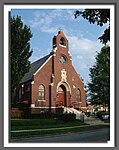Oxon Creek

Oxon Creek is a stream on the Potomac River which feeds a cove that straddles the border between Washington, D.C. and Prince George's County, Maryland just north of Interstate 495 (Capital Beltway) at Woodrow Wilson Bridge. Oxon Creek heads at the confluence of Oxon Run and Barnaby Run, sometimes referred to as Winkle Doodle Run. It starts just inside the boundary of D.C. and then runs 1.5 miles (2.4 km) to the south and west into Maryland to empty into the Potomac at Goose Island (a sand bar often under water) across from the city of Alexandria, Virginia. Before reaching the Potomac, the creek widens to form Oxon Cove which is partially in Maryland and partially in Washington, D.C.. The creek is almost entirely within Oxon Cove National Park, except for the first few feet in D.C. and a portion of the cove on the southside of the Blue Plains Advanced Wastewater Treatment Plant.Two bridges cross the creek. The Anacostia Freeway crosses it on a bridge where it becomes a tidal stream and the Oxon Hill Farm Trail crosses it where it is still narrow. The unusual spelling is either historical or a reference to Oxfordshire, England, though it was usually labelled as Oxen Creek on maps prior to 1898. The distinction between Oxon Creek and Oxon Run is often not recognized and so both are frequently referred to as Oxon Run. USGS first started labeling it as Oxon Creek in 1892.
Excerpt from the Wikipedia article Oxon Creek (License: CC BY-SA 3.0, Authors, Images).Oxon Creek
Anacostia Freeway, Washington
Geographical coordinates (GPS) Address Nearby Places Show on map
Geographical coordinates (GPS)
| Latitude | Longitude |
|---|---|
| N 38.807222222222 ° | E -77.024722222222 ° |
Address
Anacostia Freeway
Anacostia Freeway
20375 Washington
District of Columbia, United States
Open on Google Maps









